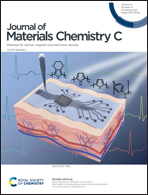Fabrication and stability of base metal electrode (Ni) on a perovskite oxide co-fired multilayer piezoelectric device†
Abstract
Conventional co-fired devices comprising a base metal electrode ferroelectric and piezoelectric ceramic are fabricated under specific reducing atmospheres. Such conditions protect the base metal (such as Ni or Cu) from oxidation, and prevent decomposition of the oxide ceramic. Such a process is complicated because few oxide compounds compatible with the base metals are stable in the required partial-pressure–temperature region. BaTiO3 is one of the few oxides that can be co-fired with Ni and Cu. Pb(ZrTi)O3 (PZT) ceramic has no compatible co-firing region with Ni and cannot be used to fabricate Ni–PZT multilayer devices. In this study, we propose a method that enables such materials to be co-sintered in air, followed by an additional annealing process. Unlike conventional methods that use a reducing atmosphere to keep the ceramic stable (e.g., pO2 = 10−12 atm at 1200 °C for BaTiO3), the Ni electrode metal is oxidized to NiO during co-sintering with the ferroelectric ceramic, Pb(MgNb)O3–PbZrTiO3 (PMNZT) at 1150 °C in air. Then, the electrode is annealed under a reducing H2/N2 atmosphere at 400 °C to convert the NiO back to Ni. The difference in the reduction kinetics between PMNZT and NiO allows the phase change of the electrode, without any decomposition of the ceramic. A porous Ni electrode layer was fabricated with a dense PMNZT ceramic layer, and the resulting piezoelectric performance of the device was comparable to that of bulk PMNZT.



 Please wait while we load your content...
Please wait while we load your content...